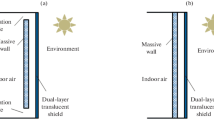Abstract
Trombe wall is a passive building energy saving technology that uses solar energy to reduce buildings’ heating load and adjust indoor thermal environment. In recent years, much research has been done to increase the thermal efficiency of Trombe wall, but little is focused on the evaluation of Trombe wall from energy, economic and environmental aspects comprehensively. Based on the thermal performance calculation method in ISO 52016-2:2017(E), the authors proposed a concise method to evaluate the energy, economic and environmental performance of ventilated and non-ventilated Trombe walls during a heating season. Firstly, non-iteration calculation methods were introduced for the energy evaluation of Trombe wall and conventional wall during the heating season. Then the economic and environmental evaluation models were brought out according to the energy performance of Trombe wall. After that, a residential building was presented as the case building to evaluate Trombe walls’ performance in five building climate zones of China. The calculation results showed that both heating degree days and solar radiation had significant impact on the energy saving effect of Trombe walls. In comparison with non-ventilated Trombe walls, ventilated ones displayed more obvious energy saving potential in all five climate regions, which can provide averagely 62% more heating for the room in the case study. Though the heating degree days of Guangzhou (hot-summer and warm-winter zone) was the smallest in the five zones, ventilated Trombe wall in the zone had the poorest economic performance due to the scarcest solar radiation during the heating season.
Similar content being viewed by others
References
Aminzade B., Collection of studies on sustainable urban development. Tehran University Press, Tehran, 2011.
Liu Z., Liu Y., He B., Xu W., Jin G., Zhang X., Application and suitability analysis of the key technologies in nearly zero energy buildings in China. Renewable and Sustainable Energy Reviews, 2018, 101: 329–345.
Liu Z., Wu D., He B., Liu Y., Zhang X., Yu H., Jin G., Using solar house to alleviate energy poverty of rural Qinghai-Tibet region, China: A case study of a novel hybrid heating system. Energy and Buildings, 2018, 178: 294–303.
Yang L., He B., Ye M., The application of solar technologies in building energy efficiency: BISE design in solar-powered residential buildings. Technology in Society, 2014, 38: 111–118.
Khalifa A.J.N., Abbas E.F., A comparative performance study of some thermal storage materials used for solar space heating. Energy and Buildings, 2009, 41(4): 407–415.
Briga Sá A.C., Martins A., Boaventura-Cunha J., Carlos Lanzinha J., Paiva A., An analytical approach to assess the influence of the massive wall material, thickness and ventilation system on the Trombe wall thermal performance. Journal of Building Physics, 2017, 41(5): 445–468.
Koyunbaba B.K., Yilmaz Z., Ulgen K., An approach for energy modeling of a building integrated photovoltaic (BIPV) Trombe wall system. Energy and Buildings, 2013, 67: 680–688.
Wang L., Li A., A numerical study of Trombe wall for enhancing stack ventilation in buildings. In Proceedings of PLEA2006—The 23rd Conference on Passive and Low Energy Architecture, Geneva, Switzerland, 6–8 September 2006.
Abbassi F., Dimassi N., and Dehmani L., Energetic study of a Trombe wall system under different Tunisian building configurations. Energy and Buildings, 2014, 80: 302–308.
Liu Z., Wu D., Li J., Yu H., He B., Optimizing building envelope dimensions for passive solar houses in the Qinghai-Tibetan region: window to wall ratio and depth of sunspace. Journal of Thermal Science, 2018. DOI: https://doi.org/10.1007/s11630-018-1047-7.
Duan S., Jing C., Zhao Z., Energy and exergy analysis of different Trombe walls. Energy and Buildings, 2016, 126: 517–523.
Corasaniti S., Manni L., Russo F., Gori F., Numerical simulation of modified Trombe-Michel Walls with exergy and energy analysis. International Communications in Heat and Mass Transfer, 2017, 88: 269–276.
Szyszka J., Simulation of modified Trombe wall. E3S Web of Conferences, 2018, 49: 00114. DOI: https://doi.org/10.1051/e3sconf/20184900114.
Briga-Sá A., Martins A., Boaventura-Cunha J., Lanzinha J.C., Paiva A., Energy performance of Trombe walls: Adaptation of ISO 13790: 2008 (E) to the Portuguese reality. Energy and Buildings, 2014, 74: 111–119.
Bojić M., Johannes K., Kuznik F., Optimizing energy and environmental performance of passive Trombe wall. Energy and Buildings, 2014, 70: 279–286.
Stazi F., Mastrucci A., Munafò P., Life cycle assessment approach for the optimization of sustainable building envelopes: An application on solar wall systems. Building and Environment, 2012, 58: 278–288.
ISO 52016-2: heat transfer and solar heat gains of windows and special elements. International standard, Switzerland, 2017.
Ruiz-Pardo Á., Domínguez S.Á., Fernandez J.A.S., Revision of the Trombe wall calculation method proposed by UNE-EN ISO 13790. Energy and Buildings, 2010, 42(6): 763–773.
Li Y., Passive solar house thermal design manual. Tsinghua University Press, Beijing, 1993. (in Chinese)
GB 50495-2009: Technical code for solar heating system, China Architecture& Building Press, Beijing, China, 2009. (in Chinese)
Lu, Y., Practical heating and air conditioning design manual, Beijing: China Architecture & Building Press, 1993. (in Chinese)
GB 50176-1993: Thermal design standards for civil building, China Planning Press, Beijing, 1993. (in Chinese)
CMA, Special meteorological data set for China’s building thermal environment analysis. China Architecture & Building Press, Beijing, 2005. (in Chinese)
Acknowledgements
The authors gratefully acknowledge the funding by China National 13th Five-Year Plan of Key Research and Development Program “The technical system and key technologies development of nearly zero-energy buildings” (2017YFC0702600).
Author information
Authors and Affiliations
Corresponding author
Rights and permissions
About this article
Cite this article
Zhang, H., Shu, H. A Comprehensive Evaluation on Energy, Economic and Environmental Performance of the Trombe Wall during the Heating Season. J. Therm. Sci. 28, 1141–1149 (2019). https://doi.org/10.1007/s11630-019-1176-7
Received:
Published:
Issue Date:
DOI: https://doi.org/10.1007/s11630-019-1176-7




